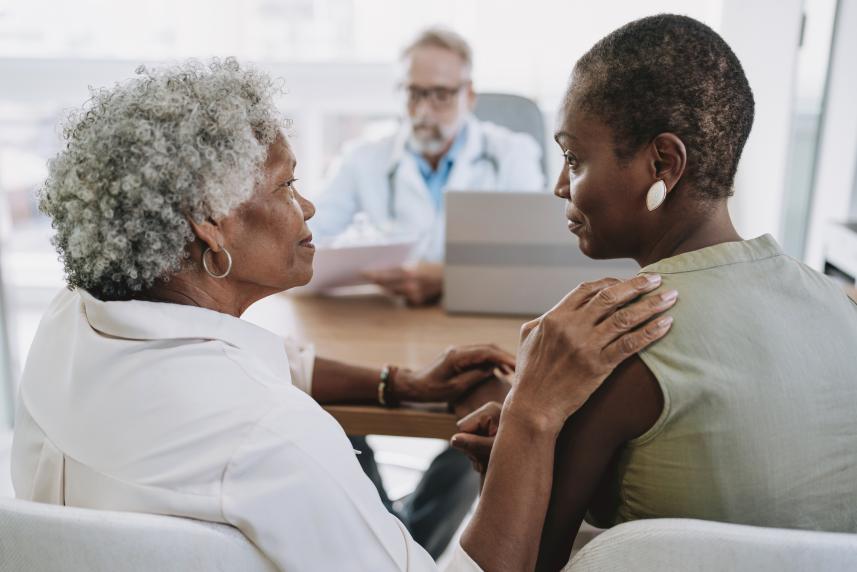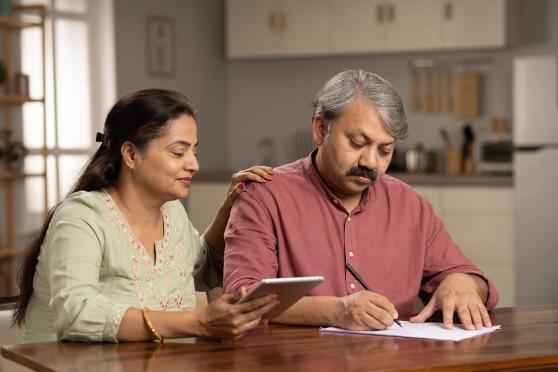Getting through breast cancer treatment
Take back control of your body during treatment for breast cancer with these strategies.

If your doctor recently told you that you need treatment for breast cancer, you might feel nervous, overwhelmed, scared, or even angry. Those reactions are completely normal. And you have every right to feel them.
“It’s okay to be scared,” stresses Andrea Kassem, R.N., a breast care nurse navigator with Baptist Health System in San Antonio. Write down those anxieties, and share them with someone close to you. After you’ve acknowledged those fears, it’s important to focus on what you can do to take back control of your body, says Kassem.
Here, Kassem offers nine tips for coping with breast cancer treatment.
1. Know your options.
After you’ve been diagnosed, your doctor, along with an entire team of technicians and other practitioners, will go over the results of all your tests. They’ll do some more tests to figure out how quickly your cancer might grow and how likely it is to have spread.
They’ll put all this valuable information together to determine your cancer’s stage (numbered from 0 to 4). You’ll also learn specifics about your tumor, with a ranking system known as Tumor, Node, Metastasis (TNM), which tells you the about the tumor’s size, its movement into your lymph nodes, and its spread into other parts of your body. Another important piece of data will tell you whether your cancer cells contain certain hormone receptors that can influence your treatment.
That’s a lot of information. Be sure to keep copies of your test results so you can refer to everything later, as you need to make decisions.
You may be prescribed a specific type of treatment based on the type of breast cancer you have, the stage, your preferences, and the side effects.
Here’s a breakdown of the types of treatments your doctor may discuss with you:
- Surgery. This involves removing either your entire breast or certain portions, as with a lumpectomy.
- Chemotherapy. Cancer-fighting chemicals are injected into your veins, or in some cases, directly into the spinal fluid. Some can also be ingested orally.
- Radiation. Cancer cells are eliminated via high beam radioactive energy.
- Hormone therapy. Used most often after surgery, hormone therapy works to prevent cancer cells from getting the hormones they need to grow and ultimately reduces the chance that cancer will return.
- Targeted therapy. This treatment uses drugs or other substances to eliminate specific cancer cells — while leaving normal cells alone.
Most likely, your doctor will recommend one, or a combination, of these treatments, depending on what stage and type of breast cancer you have.
2. Understand what side effects to expect.
Each chemotherapy drug comes with its own list of side effects. Some of the more common chemo side effects include taste bud changes, nausea, loss of appetite, hair loss, diarrhea, mental fog, nail changes, and fatigue. Your doctor or nurse can explain how long the side effects of each infusion will typically last, and when you can expect to feel better and worse.
Before your first infusion, you’ll get paperwork explaining each chemo agent and any other infused or systemic therapies you’re going to be put on, such as targeted therapy or immunotherapy. Read it through carefully and talk to your oncologist or nurse if you have any questions.
With surgery, persistent pain following the operation is a common side effect. You may require some amount of time to recover before you’re active again. With radiation therapy, common side effects include pain or tenderness in the breast area following treatment, irritation to the skin, and overall fatigue. Hormone therapy can affect your mood and libido, as well as increase your chance of experiencing night sweats or hot flashes.
3. Don’t fret too much about vomiting with chemo.
Assume you’ll be vomiting constantly? That’s a myth, says Kassem, as most doctors supply medications to prevent nausea, vomiting, and other allergic reactions. “We’ve come a long way in the journey of breast cancer,” says Kassem. “There are so many medications that can alleviate side effects before they even start.”
4. Adjust your mindset.
Kassem coaches breast cancer patients to focus on the good that the breast cancer treatment is doing to help eliminate cancer from their body, as opposed to the negative side effects it may create. “Try to look at it differently,” Kassem stresses. “This is a treatment that’s going to help you live a long, happy, [and] healthy life.”
5. Pack a treatment care bag.
If you’ve opted for chemotherapy, keep in mind that the treatment can last several hours from start to finish. Bring along some essential items from home to help you feel more comfortable, including:
- Socks and slippers. Even during the summer, it can get cold in an infusion room. Chemo can also lower your white blood cell count, making you feel colder.
- A hat or other head cover. Your head can get cold quickly as well, especially if you’ve started to lose your hair.
- Lemon drops or hard candy. Sucking on candy helps mask the taste of the saline solution used to flush your chemo port or IV before and after an infusion. Chemo can also make your mouth dry.
- Water bottle. It’s important to stay hydrated throughout your treatment. As your taste buds change, you might find that plain water isn’t appealing. Adding some sliced lemon, cucumber, or watermelon to ice water can help make it more refreshing and enjoyable.
- Hand cream and lip balm. Chemo can dry out your skin and leave you with chapped lips.
- Cozy blanket. Medications given before chemo to prevent nausea or an allergic reaction can make you sleepy. Infusion centers have warm blankets, but your own may provide a bit of emotional support, too.
6. Dress for infusion.
Wear what makes you feel comfortable. You’ll be sitting (and possibly sleeping) for several hours, so keep that in mind when getting dressed. Depending on where your port or IV is located, you’ll want to dress so that the nurse can easily access it. For ports, opt for low V-neck T-shirts or sweaters. For arm IVs, wear tops with loose or short sleeves. If you’re unsure where the port will be located, ask your doctor or nurse.
7. Reach out to support services.
Cancer care centers often have several specialists who can address various side effects of breast cancer treatment. A nutritionist can recommend different foods and recipes to deal with changing taste preferences. A psycho-oncologist or social worker can help you manage symptoms of depression. Your nurse navigator can help address any gastrointestinal side effects such as diarrhea or constipation.
8. Lean on your care team.
Regardless of the side effects, your cancer care team is there to help you 24/7. If you’re feeling miserable at home, a nurse navigator or your oncologist can provide recommendations by phone for over-the-counter treatments, or call in a prescription to your pharmacy.
“If we can nip a symptom sooner versus later, we can manage it better,” says Kassem. “If you go through your first chemo cycle and get certain side effects, tell that to your physician. We’ve got a lot of pre-medications we can tweak to make the next cycle better.”
If you have a fever that spikes to 100.5 degrees, or you experience any unusual or rare side effects listed in the paperwork, call your cancer care team immediately. They can let you know about next steps.
9. Focus on fitness.
Undergoing cancer treatment of any kind can make you feel tired and fatigued. If you need to nap, listen to your body. However, don’t overlook the role that regular fitness can play in your recovery. Walking just 30 minutes a day can give you more energy and help with anxiety, depression, and sleep problems, says Kassem. Research also shows that mild forms of exercise can decrease the chances of breast cancer recurrence.
“I really advocate for patients to be as healthy as possible,” says Kassem. “The better they eat and the more they move, the better they’re going to feel throughout treatment.”
Above all, communication is key when it comes to managing chemo and other treatment side effects, says Kassem. “It’s not something you’re supposed to be miserable throughout. We want you to be able to live with as much normalcy [as possible] and fulfill life goals.”
If you’ve had surgery to treat your breast cancer, however, it’s important to not rush fitness. Talk to your doctor about the level of activity you should maintain in the days, weeks, and months following the procedure.


